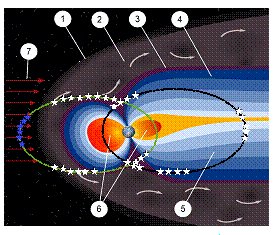New simulation code helps study electric field structure in Earth’s Magnetosphere where satellites hover
New Delhi: Scientists at the Indian Institute of Geomagnetism (IIG) an autonomous institution of the Department of Science and Technology have developed a generalized one-dimensional fluid simulation code capable of studying a wide spectrum of coherent electric field structures in near-earth plasma environment or earth’s magnetosphere which can be useful in planning of future space missions.
The Earth’s magnetosphere is a vast region which has a finite number of satellites hurtling through this realm. Hence, the in situ observations are finite and discrete. The morphology of the plasma processes around the satellite can be understood quite well. However, when they leave the observational domain of one satellite to enter into another, a vast blind arena is created. How the morphology of these processes changes over space and time can be ideally deciphered only through computer simulations.
This was the motivation for Dr. Ajay Lotekar to address the problem under the guidance of Dr. Amar Kakad from IIG. To tackle this problem, the team developed a generalized 1D fluid code which modelled the coherent electric field structures in space plasmas. They tested their code for various kinds of wave phenomena that generates coherent electric field structures in near Earth’s plasma environment. These simulations were performed on the High-Performance Computing System at IIG. The results obtained through their fluid simulation code, published in the journal Physics of Plasmas, were found to be well in agreement with the spacecraft observations of coherent electric field structures.
Almost 99% of matter in the universe is in the form of plasma, Earth’s magnetosphere, too, contains this material and the plasma processes have the ability to hamper the working of a number of satellites that have been placed in orbit in the magnetospheric region.
Apart from the well being of these expensive satellites, the academic understanding of this region is quite essential to comprehend the cosmos in its entirety. Sun is the major source of plasma deposition in space around the Earth. Sun forces some of its plasma towards the earth in the form of the solar wind. The speed of this wind varies between 300 to 1500 km/s, which carries with it solar magnetic field, called as Interplanetary Magnetic Field (IMF). The interaction of the IMF with the earth’s magnetic field creates the magnetosphere of the earth.
Figure 1: Schematic of Earth’s magnetosphere (Credit: http://web.archive.org/web/ 20070907134402/http://plasmasphere.nasa.gov/default_story.htm) with its different regions, 1) Bow shock, 2) Magnetosheath, 3) Magnetopause, 4) Northern tail lobe, 5) Southern tail lobe, 6) Plasmasphere, 7) Solar wind.The white stars indicate regions where coherent electric field structures are observed frequently, and the blue stars indicate regions where these structures are observed intermittently.
The research done by IIG researchers is focused on the coherent electric field structures that are observed in the high resolution electric field waveform data, and can be seen as isolated pulses of various forms viz., monopolar, bipolar and tripolar.
The study of complex and nonlinear wave phenomena in the magnetosphere by IIG team will help advance the knowledge of plasma waves, instabilities, and coherent effects associated with wave-particle interactions that are useful in planning of future space missions. It can also lead to precisely controlled fusion laboratory experiments for ever-expanding energy needs of humanity.

